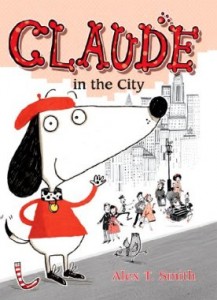 I was rather excited to check out Claude in the City
I was rather excited to check out Claude in the City, the first in a new series by Alex T. Smith. Claude is a dog (obviously) who is small, plump and who wears a beret and red sweater. He lives in a house with Mr. and Mrs. Shineyshoes and his best friend, Sir Bobblysock. Sir Bobblysock is “grubby and smells a bit like cheese.”
Every day Mr. and Mrs. Shineyshoes put on their shiny shoes and their warm coats and leave for work. Once they have departed the house, Claude and Sir Bobblysock decide on what adventures they will have that day. As is suggested by this title, in this particular story, Claude and Sir Bobblysock decide to go into the city and there they have any number of adventures.
To me, the storyline and idea of this book has promise (which is why I was curious to read it in the first place, right?). But in the end (and even before I got to the end, really) I decided that I very much did not care for the book at all. My reasons? First, Smith is trying too hard to be witty and amusing with his text and dialogue. While I do understand that the humor in this book is geared towards younger children (roughly ages 7 to 9) I’m not so sure that I want my children’s sense of humor developed in this fashion or direction. C.S. Lewis once said that a children’s story that can only be enjoyed by children is not a good children’s story in the slightest and I’m rather inclined to agree. If an adult were to talk to me like Smith talks to the readers in this book, I would have little patience for said adult. Smith’s sense of humor is good in fits and spurts but not as running dialogue and I think therein lies the problem for me.
Secondly, I really did not care for a few of the illustrations which I thought were in remarkably poor taste. (Particularly so if you are considering handing this over to a child.) In one chapter, Claude goes into an art gallery which is housing a display of sculptures. One of the sculptures is “very rude indeed” and the picture alongside the text shows a picture of a naked bottom with a heart tattooed on it. I suppose this is meant to be funny, but I really just think it is rude and appeals to a crass sense of humor which is certainly not in any need or help in being developed by any individual, no matter the age. I think we can and should require a little more from our children even in the humor department.
Potty humor and jokes about body parts are not very welcomed in our home. And if you think that is too harsh then consider how upset people are these days with the way that young men are apt to treat young women in society today. Ask me whether it is better I guide my children to other forms of humorous delight (of which there are plenty) than laughing at a naked behind. I don’t think that’s very funny. Nor did I much appreciate the illustrations of large bosomed women in low cut shirts. It’s just needless! Why should we want to focus on our children’s attention on this so early? Is it any wonder children grow up dismissive of personal privacy, dignity and respect when they are subjected to the idea that showing off body parts is humorous and meant to be funny? I’m very much not advocating Victorian dress wear, but rather respect for the human body which does require modesty. Also it requires a concentrated effort on the part of the parents to teach their children what is funny and laughable and what is not. I don’t find very much humor in Claude and so, to my great disappointment, I will be setting this aside. I cannot recommend it. But I can make you aware of it.
That all said, I do appreciate Peachtree Publishers for giving me a crack at this book in exchange for my honest opinion.
Carrie blogs about the books she loves as well as some she doesn’t over at readingtoknow.com.
It does look cute — I love the cover — and sounds like a great idea. I agree about the potty humor and the illustrations. I find that in a lot of animated “kids’ movies” as well.
However, I do know that some parents are willing to look the other way from the very popular potty humor with the trade-off being that their kids (sons usually) will actually read. It’s a fine line.